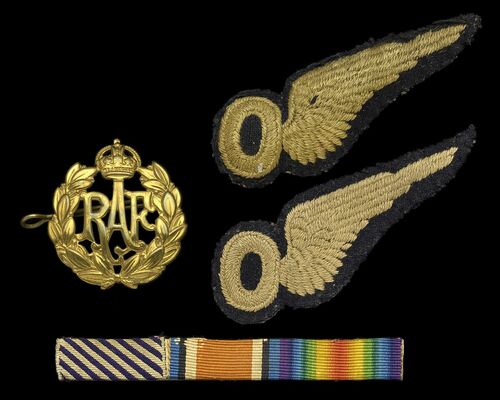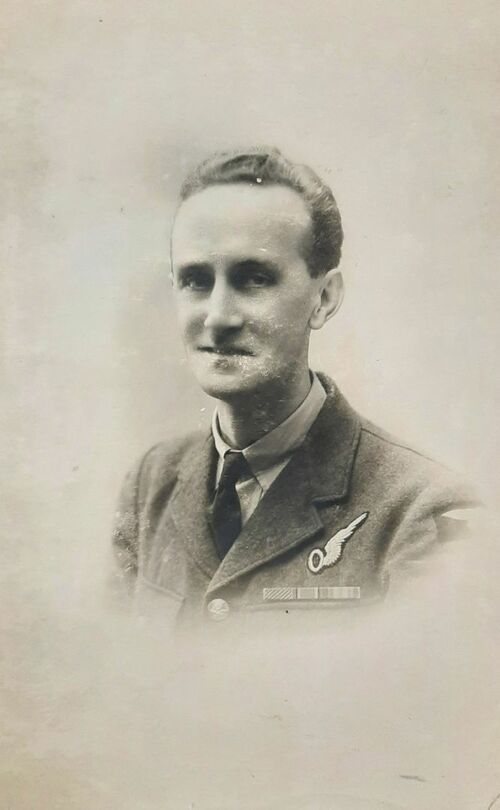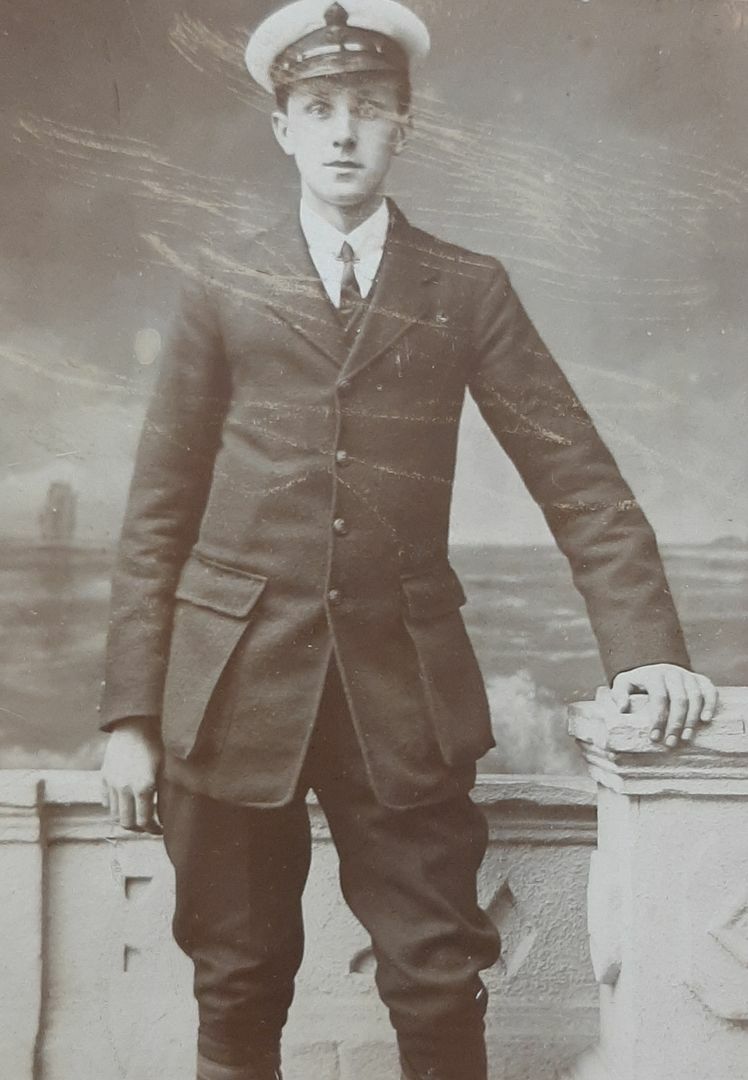Auction: 24001 - Orders, Decorations and Medals
Lot: 223
Sold by Order of the Family
A superb and well-documented 'Otranto Barrage' 1918 D.F.M. group of three awarded to Air Mechanic Class I D. L. Moxey, Royal Air Force, who saw service in both wars witnessing the sinking of the Lancastria in 1940
Distinguished Flying Medal, G.V.R. (203962 A.M.2. D. L. Moxey. R.A.F.), in its named card box of issue; 1939-45 Star; War Medal 1939-45, with slip of issue, good very fine (3)
D.F.M. London Gazette 20 September 1918:
‘An excellent gunlayer observer. During a late raid he shot down and destroyed an Austrian seaplane, displaying marked skill and resource.’
David Lewis Moxey was born at Lambeth, London on 4 April 1896 and worked as an engineer’s draftsman prior to enlisting with the Royal Naval Air Service on 16 April 1915. Graded as Air Mechanic Class II Moxey was listed as posted to France with No. 3 Wing likely in June 1916. No. 3 Wing had served in the Gallipoli Campaign but was later disbanded only to be re-formed in France in May 1916 at Luxeuil-les-Bains, although no personnel were on the ground until June.
From their base at Luxeuil-les-Bains the Wing was tasked with attacking German industry, a difficult task made harder by German aircraft and poor weather. Moxey was promoted Air Mechanic Class I while serving in France on 15 December 1916. He was not to remain there for much longer however, returning to Britain by 25 April 1917 where a brisk series of postings soon saw him on the books of Queen II the R.N.A.S. base responsible for the Otranto Barrage. He was graded as Air Mechanic (Gunlayer) on 10 October 1917 giving him the role of rear gunner/ Observer and joined Queen II for No. 6 Wing on 10 November that same year.
The Otranto Barrage was a blockade between Brindisi in Southern Italy and Corfu, intended to prevent the Central Powers from accessing the Mediterranean from the Austrian controlled ports in the Baltic. Unfortunately a lack of resources made this blockade largely ineffective and air assets like No. 6 Wing were essential for their reconnaissance capabilities. Moxey's arrival coincided with an attempt to improve the effectiveness of the Barrage in late 1917 as outlined in the book Naval Strategy and Operations in Narrow Seas which states:
'The Allies tightened their control of the Strait of Otranto at the conference in Rome held in November 1917. They decided to greatly improve the barrage by speeding up delivery of material to establish an anchored-net barrage and net mines between Otranto, Fano, and Corfu. In addition, about 90 destroyers and submarine chasers (SCs), 125 fishing steamers and a number of seaplanes were used in this effort. The British base at Otranto and the French base in Corfu were primarily used in the search for U-boats. These measures came into effect in May 1918 and remained in force until the end of war.'
Moxey was present at Otranto when the R.N.A.S. and the Royal Flying Corps combined to form the Royal Air Force in the Spring of 1918. Here No. 6 Wing R.N.A.S was reformed into No. 66 Wing R.A.F., although they continued to perform the same function. It was not long after this that he was awarded the Distinguished Flying Medal for his part in a successful combat with an Austrian seaplane.
With the end of the War he was posted to 5 Aircraft Repair Depot on 19 December 1918. Moxey was to serve there for several months before finally being demobilised on 3 February 1919 at Kinross Dispersal Centre (British War & Victory Medals).
After the war he was posted to the R.A.F. Reserve and joined the Civil Service as a Clerk, he was appointed as Special Clerk with the Inland Revenue on 9 October 1936. Enlisting to with the Royal Air Force again on 29 July 1939 as a reservist with war looming, Moxey was rated as a Draughtsman. On the outbreak of war he was mobilised as Aircraftman and posted to France where he witnessed the 1940 campaign and the Fall of France. As the British Forces were driven back the R.A.F. found themselves forced to withdraw towards the coast and evacuate where they could. A letter written by Flight Lieutenant Les Gillard, Moxey's nephew expands upon his experiences here stating:
'In June 1940. Dave's RAF unit was on the run from the German Panzer units. They arrived at St. Nazaire in the Loire Estuary in Western France, to find that the ship they were expecting to board was full up with evacuating civilians and soldiers. The ship was the "Lancastria". Dave saw the ship being bombed and susequently [SIC] go down. Dave was able to board another smaller ship later on which safely returned to England.'
The sinking of the Lancastria was one of the worst disasters of the evacuation, with the liner being severely overloaded. Moxey was to witness the tragic sinking as it unfolded before being evacuated to Britian where he continued to serve with the R.A.F. Unfortunately the strains of service began to weight heavily on him and he was discharged as a result of ill health on 15 February 1943. His statement of conduct at this time reads 'This airman was superior in his trade as a Draughtsman, his general character and conduct was excellent.'
Moxey returned to London where he lived at 55 Abbotsbuy Road, Morden. He died in 1960 and his funeral was held on 3 November 1960 at Streatham Park; sold together with copied citation, R.N.A.S. and R.A.F. service records along with a large archive of original material comprising:
(i)
Four photographs.
(ii)
Identity tags and a riband bar with the recipient's Great War campaign awards represented.
(iii)
A whistle; set of keys; comb; handkerchief and penknife.
(iv)
Two sets of Observer's Wings.
(v)
An R.A.F. cap badge; R.N.A.S. badge, silver, hallmarked for London 1915 and a British Legion Enamelled Badge numbered '791755'.
(vi)
Brief Statement of Service and Discharge Certificate.
(vii)
Slip relating details of the recipient's Funeral.
(viii)
Certificate of Birth for the recipient's wife.
(ix)
Copied letters from the recipient's Nephew, himself a Flight Lieutenant in the Royal Air Force, giving details of the recipient's service.
(x)
Extracts from articles relating to the RE8 reconnaissance aircraft and the sinking of the Lancastria.
(xi)
Several documents of issue and communications relating to the award of the D.F.M..
Subject to 20% VAT on Buyer’s Premium. For more information please view Terms and Conditions for Buyers.
Sold for
£1,700
Starting price
£1300













